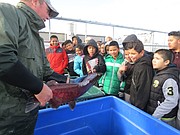Elementary school kids get an up-close look at salmon spawning
MATTAWA — A smattering of small, bright-orange orbs lay on the dark asphalt of the Priest Rapids Hatchery spawning area like pearls suddenly set free from a broken necklace. They attracted fifth graders like a magnet.
“What’s that,” one of boys asked? He bent over for a closer look. “Eeeew! Don’t touch it,” said another rushing over as a huddle quickly formed and clamor grew around and over the curious spheres. “What could they be?”
More than 60 inquisitive fifth graders along with their teachers Erin Tostenson and Laura Catlin from Morris Schott STEAM Elementary in Mattawa got an up-close look at thousands of fall Chinook salmon eggs during the spawning process at Priest Rapids Hatchery Nov. 6
Led by Grant PUD biologists Eric Lauver and Rolland O’Connor, the group watched state Department of Fish and Wildlife hatchery workers corral the previously trapped Chinook, euthanize them with a blow to the head, and then toss them onto a special tray for the next step in the process.
The fish processors expertly slicing open the females, caught thousands of eggs in white buckets, and then squirted the white “milt” — seminal fluid — from the males into the buckets to fertilize the eggs.
“What you’ve just seen is the spawning process,” Lauver told the group. “The female in the would dig what in the gravel?”
“A redd” the kids responded. A redd is a depression in a riverbed the female excavates with swishes of her tail that holds her deposit of eggs — somewhere between 3,600 and 4,000 of them.
Tostenson said students have been studying the salmon lifecycle as part of an ecosystem lesson at school.
“We’re learning what the PUD does to maintain the health of the river, and what they (the students) can do,” she said. “Each classroom built a terrarium on top of an aquarium filled with guppies and snails to observe whatever is deposited into the terrarium soil could leach into the water below, affecting the aquatic flora and fauna.”
The PUD spends about $15 million annually to support operations, making habitat improvements, controlling birds and fish that feast on young salmon, monitoring and evaluating hatchery and wild fish populations in the region, and maintaining approximately 20 hatcheries and fish-rearing facilities throughout the Columbia Basin.
Lauver told the kids how crews at the hatchery place fertilized salmon eggs into incubated trays filled with circulating cold water until they develop into tiny “frye” — baby fish. The process takes about 12 weeks.
As the Chinook grow, they’re transferred first to outdoor raceways inside chain-link cages to protect them from predators, then to larger rearing tanks until they’re ready for release into the Columbia River for their 400-mile journey to the ocean. Many of the Chinook spawn naturally right in the hatchery’s water-filled channel to the Columbia.
The tour ended with the students getting a close-up look at the females and bright-red males doing what nature intended. The females, Lauver told the kids, will stay within the redd until they get so weak they fall over and die.
“Oh, pobrecitos (poor things),” student Francisco Capi said softly as he headed off with his classmates to board the bus.





